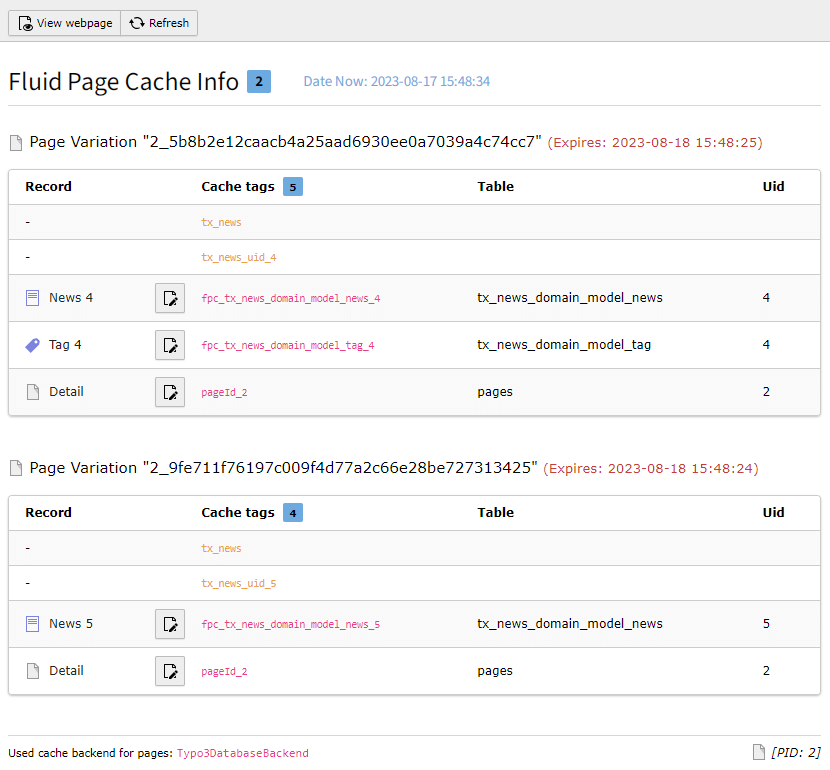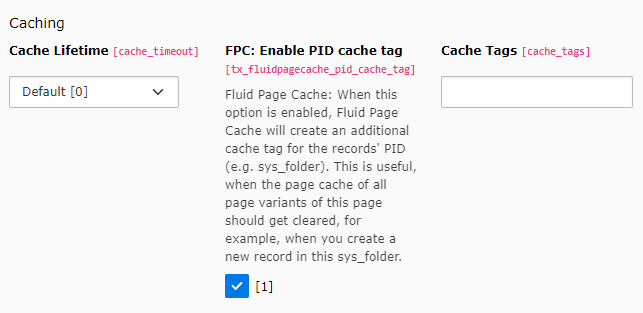Usage¶
fluid_page_cache works out of the box, when it is installed.
Backend Module¶
fluid_page_cache ships a Backend Module which allows you to see the records used in view, for each page variation in page cache.

Caution
The Backend Module does not work for all Cache backends, yet.
Supported cache backends are:
Typo3Database
Redis
SimpleFile
When you use e.g. APCU, the info module will not work. But, the main functionality of fluid_page_cache is not affected. It supports all cache backends, the Caching Framework is compatible with.
Hint
The Backend Module has restricted access, only admin users can see it. You can also disable or enable the Backend Module in extension settings.
Handling new records¶
fluid_page_cache works with zero configuration, but also adds a new option to pages cache options:

When this option is enable, Fluid Page Cache will create an additional cache tag for the records' PID (e.g. sys_folder).
This is especially useful, when the page cache of all page variants of this page should get cleared, for example when you create a new record in a sys_folder.
Therefore this option makes sense to enable for pages, which primarily contains lists of records (with/without paginations).
If you not activate this option on such pages, a new record in a related sys_folder will have no effect to page cache at all.
So, you should not enable this option for dedicated detail pages. Otherwise their cache would also get cleared, when new records have been created.
Register cache tags manually¶
fluid_page_cache is just able to create cache tags for used entities in view, when they get passed into the template using variables.
View helpers like f:cObject provide own data, which the variable container in Fluid does not know about.
View helper¶
To be still able to provide cache tags here, fluid_page_cache ships a view helper, you can use in your templates.
Example Fluid template:
{namespace fpc=T3\FluidPageCache\ViewHelpers}
<f:cObject typoscriptObjectPath="lib.contentElementRendering">{element.uid}</f:cObject>
<fpc:registerCacheTag table="tt_content" uid="{element.uid}" pid="{element.pid}" />
PageCacheManager class¶
The central class \T3\FluidPageCache\PageCacheManager is entry point for all parts of this extension.
You can call the static method registerCacheTag from everywhere you want.
PageCacheManager::registerCacheTag($table, $uid, $pid);
Keep in mind, that fluid_page_cache only apply:
when
TYPO3_MODEconstant isFE$GLOBALS['TSFE']is set
The pid is used to create an additional cache tag for the related e.g. sys_folder. It only applies when
the setting tx_fluidpagecache_pid_cache_tag in page settings, is enabled.
If you want to register an Extbase entity manually, you can use the static registerEntity method:
$entity = $this->myRepository->findByUid(1);
PageCacheManager::registerEntity($entity);
$entity must be:
an instance of
\TYPO3\CMS\Extbase\DomainObject\AbstractDomainObjectpersisted (and have an uid available)
All cache tags made with fluid_page_cache got this syntax:
fpc_{table_name}_{uid}
{table_name} may also store the keyword pid, which is related to tx_fluidpagecache_pid_cache_tag option
in page settings.
DataHandler Hook¶
Creating cache tags does only make sense when you use them to clear specific cache entries.
fluid_page_cache provides an after-save-hook, which is triggered each time you modify a record using the DataHandler (e.g. editors in backend).
When a new record is created, e.g. in a sys_folder, the cache tag fpc_pid_{uid of current page} is cleared.
This cache tag only applies to pages, which have the setting FPC: Enable PID cache tag enabled.
It applies automatically, when fluid_page_cache is installed.
